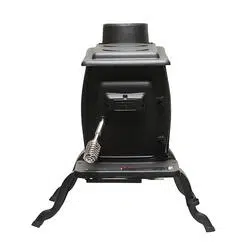Loading ...
Loading ...
Loading ...

-11-
It is EXTREMELY IMPORTANT that you use DRY WOOD only in your wood stove. The wood should have dried for 9
to 15 months, such that the humidity content (in weight) is reduced below 20% of the weight of the log. It is very
important to keep in mind that even if the wood has been cut for one, two or even more years, it is not necessarily
dry if it has been stored in poor conditions. Under extreme conditions, it may rot, instead of drying. This point
cannot be overstressed; the vast majority of the problems related to the operation of a wood stove is caused by
the fact that the wood used was too damp or has dried in poor conditions. These problems can be:
– ignition problems
– creosote build-up causing chimney res
– low energy yield
– blackened windows
– incomplete log combustion
Smaller pieces of wood will dry faster. All logs exceeding 6” in diameter should be split. The wood should not be
stored directly on the ground. Air should circulate through the cord. A 24” to 48” air space should be left between
each row of logs, which should be placed in the sunniest location possible. The upper layer of wood should be
protected from the elements but not the sides.
TESTING THE WOOD
• When the stove is thoroughly warmed, place one piece of split wood (about ve inches in diameter) parallel
to the door on the bed of red embers.
• Keep the air control fully open by pulling on it and close the door. If the ignition of the piece is accomplished
within 90 seconds from the time it was placed inside the stove, the wood is correctly dried. If ignition takes
longer, the wood is damp.
• If the wood hisses and water or vapor escapes at the ends of the piece, the wood is soaked or freshly cut.
Do not use this wood in the stove. Large amounts of creosote could be deposited in the chimney, creating
potential conditions for a chimney re.
TAMPER WARNING
This wood heater has a manufacturer-set minimum low burn rate that must not be altered. It is against federal
regulations to alter this setting or otherwise operate this wood heater in a manner inconsistent with operating
instructions in this manual.
THE FIRST FIRES
The fresh paint on this stove needs to be cured to preserve its quality. Once the fuel charge is properly ignited,
only burn small res in the stove for the rst four hours of operation. Make sure that there’s enough air circulation
while curing the stove. The odors could be smelled during the 3 or 4 rst res. Never start your stove outside. A
person will not be able to see if the unit is overheating.
CAUTION: Never alter the damper slide or the adjustment range to increase ring for any reason. Doing so
could result in heater damage and will void your warranty.
TYPE
WEIGHT
(LBS. CU. FT., DRY)
PER CORD
EFFICIENCY
RANKING
SPLITS
M I L L I O N S
BTU’s/CORD
Hickory 63 4500 1.0 Well 31.5
White Oak 48 4100 .9 Fair 28.6
Red Oak 46 3900 .8 Fair 27.4
Beech 45 3800 .7 Hard 26.8
Sugar Maple 44 3700 .6 Fair 26.2
Black Oak 43 3700 .6 Fair 25.6
Ash 42 3600 .5 Well 25.0
Yellow Birch 40 3400 .4 Hard 23.8
Red Maple 38 3200 .3 Fair 22.6
Paper Birch 37 3100 .3 Easy 22.1
Elm/Sycamore 34 2900 .2 Very Difcult 20.1
Red Spruce 29 1800 .1 Easy 16.1
Any type of wood may be used in your stove, but specic varieties have better energy yields than others. Please
consult the following table in order to make the best possible choice.
Loading ...
Loading ...
Loading ...
